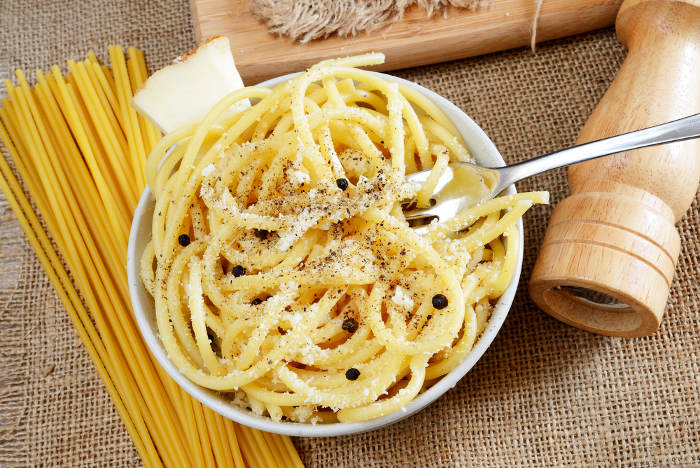
Once in Rome, you’ll be going to see the sights, and take in the history and culture. OK, but remember that Rome, as well as being the capital as we have said, is also a capital of Italian gastronomy. And in this blog I also talk about Italian cuisine and recipes. One of Rome’s most famous dishes is undoubtedly the pasta dish cacio e pepe. If you come to Rome it’s an absolute must to have spaghetti – or more precisely tonnarelli cacio e pepe for lunch or dinner – in some little traditional restaurant – or trattoria – in the city centre. Let me tell you about the ingredients of this dish and how to prepare it, so you can make it at home, wherever you are in the world!
Ingredients
400 g spaghetti | 200 g pecorino romano cheese | black pepper | extra virgin olive oil | salt
Method
Like any good, self-respecting local Italian cuisine this dish is an easy pasta recipe with very few ingredients. I’d call it a truly “honest” dish. But, beware: simplicity in the culinary arts can sometimes have its pitfalls, so you’ll need to follow my instructions to the letter if you want to end up with a dish that’s the real thing! Take a large saucepan and cook the spaghetti in plenty of lightly-salted water. In a separate frying pan, add the cheese – grated – and the ground black pepper. Mix well, adding a little of the hot water from the pasta saucepan. When the pasta is ready – al dente – don’t drain it but rather lift it straight from the hot water (using a large “spaghetti fork”) and add it to the saucepan containing the cheese and pepper. Stir the pasta in, adding a little more of the hot water until you get a sort of cheese and pepper sauce. But take note, this stirring in should be done off the heat, otherwise you’ll cook the cheese and it’ll turn lumpy. So, to recap: here are the main points again:
– Cacio – the cheese: by ‘cheese’, I mean only pecorino romano. Other Italian pecorini cheeses will not work here, nor will any other types of cheese such as parmesan.
– Other ingredients: only those listed in the recipe should be used, so no oil, no cream, no butter, …
– Pasta: the best type of pasta to use is spaghetti – the type called “tonnarelli”. In my opinion, bucatini (like in the photo at the top of this post) are also OK to use. If there are a lot of you eating, it might be better to use short pasta which in large quantities will be easier to stir into the sauce.
– Method (1): don’t drain the pasta otherwise you’ll lose all the water and you need some of it to get the sauce to the right consistency.
– Method (2): don’t stir the pasta into the sauce in the frying pan when over heat. Turn off the heat first.
Serve immediately – and buon appetito! Enjoy!


Leave A Comment